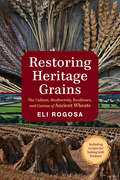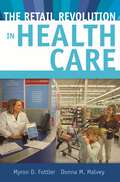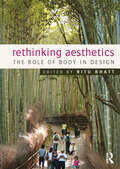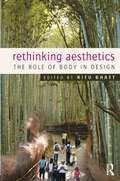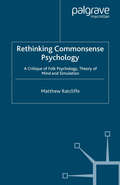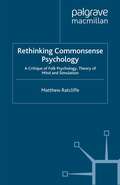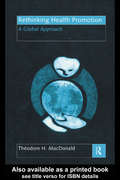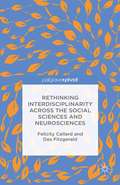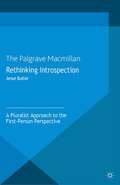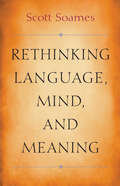- Table View
- List View
The Restless Clock: A History of the Centuries-Long Argument over What Makes Living Things Tick
by Jessica RiskinToday, a scientific explanation is not meant to ascribe agency to natural phenomena: we would not say a rock falls because it seeks the center of the earth. Even for living things, in the natural sciences and often in the social sciences, the same is true. A modern botanist would not say that plants pursue sunlight. This has not always been the case, nor, perhaps, was it inevitable. Since the seventeenth century, many thinkers have made agency, in various forms, central to science. The Restless Clock examines the history of this principle, banning agency, in the life sciences. It also tells the story of dissenters embracing the opposite idea: that agency is essential to nature. The story begins with the automata of early modern Europe, as models for the new science of living things, and traces questions of science and agency through Descartes, Leibniz, Lamarck, and Darwin, among many others. Mechanist science, Jessica Riskin shows, had an associated theology: the argument from design, which found evidence for a designer in the mechanisms of nature. Rejecting such appeals to a supernatural God, the dissenters sought to naturalize agency rather than outsourcing it to a “divine engineer.” Their model cast living things not as passive but as active, self-making machines. The conflict between passive- and active-mechanist approaches maintains a subterranean life in current science, shaping debates in fields such as evolutionary biology, cognitive science, and artificial intelligence. This history promises not only to inform such debates, but also our sense of the possibilities for what it means to engage in science—and even what it means to be alive.
The Restless Clock: A History of the Centuries-Long Argument over What Makes Living Things Tick
by Jessica RiskinToday, a scientific explanation is not meant to ascribe agency to natural phenomena: we would not say a rock falls because it seeks the center of the earth. Even for living things, in the natural sciences and often in the social sciences, the same is true. A modern botanist would not say that plants pursue sunlight. This has not always been the case, nor, perhaps, was it inevitable. Since the seventeenth century, many thinkers have made agency, in various forms, central to science. The Restless Clock examines the history of this principle, banning agency, in the life sciences. It also tells the story of dissenters embracing the opposite idea: that agency is essential to nature. The story begins with the automata of early modern Europe, as models for the new science of living things, and traces questions of science and agency through Descartes, Leibniz, Lamarck, and Darwin, among many others. Mechanist science, Jessica Riskin shows, had an associated theology: the argument from design, which found evidence for a designer in the mechanisms of nature. Rejecting such appeals to a supernatural God, the dissenters sought to naturalize agency rather than outsourcing it to a “divine engineer.” Their model cast living things not as passive but as active, self-making machines. The conflict between passive- and active-mechanist approaches maintains a subterranean life in current science, shaping debates in fields such as evolutionary biology, cognitive science, and artificial intelligence. This history promises not only to inform such debates, but also our sense of the possibilities for what it means to engage in science—and even what it means to be alive.
The Restless Clock: A History of the Centuries-Long Argument over What Makes Living Things Tick
by Jessica RiskinToday, a scientific explanation is not meant to ascribe agency to natural phenomena: we would not say a rock falls because it seeks the center of the earth. Even for living things, in the natural sciences and often in the social sciences, the same is true. A modern botanist would not say that plants pursue sunlight. This has not always been the case, nor, perhaps, was it inevitable. Since the seventeenth century, many thinkers have made agency, in various forms, central to science. The Restless Clock examines the history of this principle, banning agency, in the life sciences. It also tells the story of dissenters embracing the opposite idea: that agency is essential to nature. The story begins with the automata of early modern Europe, as models for the new science of living things, and traces questions of science and agency through Descartes, Leibniz, Lamarck, and Darwin, among many others. Mechanist science, Jessica Riskin shows, had an associated theology: the argument from design, which found evidence for a designer in the mechanisms of nature. Rejecting such appeals to a supernatural God, the dissenters sought to naturalize agency rather than outsourcing it to a “divine engineer.” Their model cast living things not as passive but as active, self-making machines. The conflict between passive- and active-mechanist approaches maintains a subterranean life in current science, shaping debates in fields such as evolutionary biology, cognitive science, and artificial intelligence. This history promises not only to inform such debates, but also our sense of the possibilities for what it means to engage in science—and even what it means to be alive.
The Restless Clock: A History of the Centuries-Long Argument over What Makes Living Things Tick
by Jessica RiskinToday, a scientific explanation is not meant to ascribe agency to natural phenomena: we would not say a rock falls because it seeks the center of the earth. Even for living things, in the natural sciences and often in the social sciences, the same is true. A modern botanist would not say that plants pursue sunlight. This has not always been the case, nor, perhaps, was it inevitable. Since the seventeenth century, many thinkers have made agency, in various forms, central to science. The Restless Clock examines the history of this principle, banning agency, in the life sciences. It also tells the story of dissenters embracing the opposite idea: that agency is essential to nature. The story begins with the automata of early modern Europe, as models for the new science of living things, and traces questions of science and agency through Descartes, Leibniz, Lamarck, and Darwin, among many others. Mechanist science, Jessica Riskin shows, had an associated theology: the argument from design, which found evidence for a designer in the mechanisms of nature. Rejecting such appeals to a supernatural God, the dissenters sought to naturalize agency rather than outsourcing it to a “divine engineer.” Their model cast living things not as passive but as active, self-making machines. The conflict between passive- and active-mechanist approaches maintains a subterranean life in current science, shaping debates in fields such as evolutionary biology, cognitive science, and artificial intelligence. This history promises not only to inform such debates, but also our sense of the possibilities for what it means to engage in science—and even what it means to be alive.
The Restless Clock: A History of the Centuries-Long Argument over What Makes Living Things Tick
by Jessica RiskinToday, a scientific explanation is not meant to ascribe agency to natural phenomena: we would not say a rock falls because it seeks the center of the earth. Even for living things, in the natural sciences and often in the social sciences, the same is true. A modern botanist would not say that plants pursue sunlight. This has not always been the case, nor, perhaps, was it inevitable. Since the seventeenth century, many thinkers have made agency, in various forms, central to science. The Restless Clock examines the history of this principle, banning agency, in the life sciences. It also tells the story of dissenters embracing the opposite idea: that agency is essential to nature. The story begins with the automata of early modern Europe, as models for the new science of living things, and traces questions of science and agency through Descartes, Leibniz, Lamarck, and Darwin, among many others. Mechanist science, Jessica Riskin shows, had an associated theology: the argument from design, which found evidence for a designer in the mechanisms of nature. Rejecting such appeals to a supernatural God, the dissenters sought to naturalize agency rather than outsourcing it to a “divine engineer.” Their model cast living things not as passive but as active, self-making machines. The conflict between passive- and active-mechanist approaches maintains a subterranean life in current science, shaping debates in fields such as evolutionary biology, cognitive science, and artificial intelligence. This history promises not only to inform such debates, but also our sense of the possibilities for what it means to engage in science—and even what it means to be alive.
Restorative Rituals: Ideas and Inspiration for Self-Care
by Leslie KorenA daily dose of calm, with dozens of relaxing, nourishing, and rejuvenating rituals—all lushly photographed and in an irresistible impulse format.
Restorative Yoga: Power, Presence and Practice for Teachers and Trainees
by Anna AshbyFrom Anna Ashby, one of the first yoga teachers in the UK to offer this style, comes a complete overview of restorative yoga for teachers, trainees and experienced students. Arranged into three sections, the book is designed to help readers understand the history, purpose and characteristics of the practice; its feel and expression with an emphasis on breath, process and introspection; and how to structure a successful practice. Each section ends with self-enquiry and breath exploration so teachers can practically apply the knowledge shared in each chapter and build a framework for a successful teaching practice.Helping the reader to understand their own patterns of behaviour and cultural imprints, which may interfere with the ability to downshift the nervous system and ultimately relax, Restorative Yoga supplies all the necessary preparations to successfully teach this style of yoga.
Restorative Yoga for Ethnic and Race-Based Stress and Trauma: A Visual Introduction (Therapeutic Parenting Bks.)
by Gail ParkerPresenting ways in which Restorative Yoga can contribute to healing emotional wounds, this book invites yoga teachers, therapists and practitioners to consider the psychological impact of ethnic and race-based stress and trauma. It aids in the process of uncovering, examining, and healing one's own emotional wounds and offers insight into avoiding wounding or re-wounding others. The book describes how race-based traumatic stress differs from PTSD and why a more targeted approach to treatment is necessary, as well as what can trigger it. It also considers the implications of an increasingly racially and ethnically diverse and global yoga community, as well as the importance of creating conscious yoga communities of support and connection, where issues of race and ethnicity are discussed openly, non-defensively and constructively.By providing a therapeutic structure that assists those directly and indirectly impacted by ethnic and race-based stress and trauma, Restorative Yoga for Ethnic and Race-Based Stress and Trauma provides valuable tools for aiding in the processing of stressful experiences and in trauma recovery.
Restore: Ancient Remedies from the Modern Kitchen
by Lizzie KingBoost your resilience and combat the rigours of modern living.For anyone who is suffering from insomnia, Lizzie King has just the cure. After a hideous clock-change week that left her family devoid of rest, she turned to her knowledge as a nutritional health coach and created a 'sleep tight' smoothie. Restore is filled with 100 such ingenious recipes for you and your home – from tonics that ease hay fever and balms for anxiety, syrups for avoiding the seasonal lurgies or coping with a sick bug, to fizzing bath bombs, edible face masks, lickable kitchen sprays and more. There's even a few especially for your dog.You don't need chemicals to create an effective remedy or cleaner, nor do you have to be naturally crafty: the recipes are fuss-free, and many of the ingredients are likely to be in your pantry already.Our world is glittering with natural ingredients, many that have been used for millennia as remedies without damaging side-effects for us or our planet. Restore will help you to thrive in optimal health.
Restoring Heritage Grains: The Culture, Biodiversity, Resilience, and Cuisine of Ancient Wheats
by Eli RogosaIncluding recipes for baking with Einkorn Wheat is the most widely grown crop on our planet, yet industrial breeders have transformed this ancient staff of life into a commodity of yield and profit—witness the increase in gluten intolerance and 'wheat belly’. Modern wheat depends on synthetic fertilizer and herbicides that damage our health, land, water, and environment. Fortunately, heritage ‘landrace' wheats that evolved over millennia in the organic fields of traditional farms do not need bio-chemical intervention to yield bountifully, are gluten-safe, have rich flavor and high nutrition. Yet the robust, majestic wheats that nourished our ancestors are on the verge of extinction. In Restoring Heritage Grains, author Eli Rogosa of the Heritage Grain Conservancy, invites readers to restore forgotten wheats such as delicious gluten-safe einkorn that nourished the first Neolithic farmers, emmer—the grain of ancient Israel, Egypt, and Rome that is perfect for pasta and flatbreads, rare durums that are drought-tolerant and high in protein, and many more little known wheat species, each of which have a lineage intertwined with the human species and that taste better than any modern wheat. Restoring Heritage Grains combines the history of grain growing and society, in-depth practical advice on landrace wheat husbandry, wheat folk traditions and mythology, and guidelines for the Neolithic diet with traditional recipes for rustic bread, pastry and beer. Discover the ancient grains that may be one of the best solutions to hunger today, and provide resilience for our future.
Restoring Prana: A Therapeutic Guide to Pranayama and Healing Through the Breath for Yoga Therapists, Yoga Teachers, and Healthcare Practitioners
by Robin L. RothenbergOne of the most common issues clients face is lack of energy, vitality or prana and this book presents a simple yet revolutionary breathing approach to restore balance. Grounded in the yogic teachings, this text introduces the Buteyko breathing method as a more contemporary way of understanding the original intention of pranayama. Through extensive research, Robin Rothenberg establishes that as with Dr. Buteyko's breath retraining technique, the ancient yogis prescribed breathing less not more. Vedic science and physiology are broken down and explained in accessible ways. The book presents a new understanding and application of breathing to address a wide range of ailments, including COPD, asthma, hay-fever, autoimmune disorders, anxiety, sleep apnoea and neurological conditions.
Restoring the Human Context to Literary and Performance Studies: Voices in Everything (Cognitive Studies in Literature and Performance)
by Howard Mancing Jennifer Marston WilliamRestoring the Human Context to Literary and Performance Studies argues that much of contemporary literary theory is still predicated, at least implicitly, on outdated linguistic and psychological models such as post-structuralism, psychoanalysis, and behaviorism, which significantly contradict current dominant scientific views. By contrast, this monograph promotes an alternative paradigm for literary studies, namely Contextualism, and in so doing highlights the similarities and differences among the sometimes-conflicting contemporary cognitive approaches to literature and performance, arguing not in favor of one over the other but for Contextualism as their common ground.
The Retail Revolution in Health Care
by Myron D. Fottler Donna M. MalveyThis book unveils and demystifies a revolution occurring in health care in the United States and beyond and how it will reform the health care system.There is something new in health care. Retail clinics, sometimes partnering with prestigious health-care institutions such as the Cleveland Clinic, offer an affordable, accessible solution for delivering primary-care services to underserved populations. The Retail Revolution in Health Care presents an overview of the retail health trend and its implications for consumers, employers, health care providers, health care companies, insurers, and health policy makers.The authors examine the phenomenon of retail health care from an entrepreneurial perspective, discussing the growth of retail care beyond traditional retail establishments and possible performance indicators to assess health outcomes. They report on the differing perspectives of retail care from a variety of experts, including doctors, nurses, patients, and insurers. Finally, they address business realities in the United States and globally as they affect the clinics. Retail clinics will almost certainly play a key role as either an alternative to national health insurance or a component of health reform. This important book explores their part in furthering the availability of health care for all Americans.
Rethinking Aesthetics: The Role of Body in Design
by Ritu BhattRethinking Aesthetics is the first book to bring together prominent voices in the fields of architecture, philosophy, aesthetics, and cognitive sciences to radically rethink the relationship between body and design. These essays argue that aesthetic experiences can be nurtured at any moment in everyday life, thanks to recent discoveries by researchers in neuroscience, phenomenology, somatics, and analytic philosophy of the mind, who have made the correlations between aesthetic cognition, the human body, and everyday life much clearer. The essays, by Yuriko Saito, Juhani Pallasmaa, and Richard Shusterman, among others, range from an integrated mind-body approach to chair design, to Zen Buddhist notions of mindfulness, to theoretical accounts of existential relationships with buildings, to present a full spectrum of possible inquiries. By placing the body in the center of design, Rethinking Aesthetics opens new directions for rethinking the limits of both essentialism and skepticism.
Rethinking Aesthetics: The Role of Body in Design
by Ritu BhattRethinking Aesthetics is the first book to bring together prominent voices in the fields of architecture, philosophy, aesthetics, and cognitive sciences to radically rethink the relationship between body and design. These essays argue that aesthetic experiences can be nurtured at any moment in everyday life, thanks to recent discoveries by researchers in neuroscience, phenomenology, somatics, and analytic philosophy of the mind, who have made the correlations between aesthetic cognition, the human body, and everyday life much clearer. The essays, by Yuriko Saito, Juhani Pallasmaa, and Richard Shusterman, among others, range from an integrated mind-body approach to chair design, to Zen Buddhist notions of mindfulness, to theoretical accounts of existential relationships with buildings, to present a full spectrum of possible inquiries. By placing the body in the center of design, Rethinking Aesthetics opens new directions for rethinking the limits of both essentialism and skepticism.
Rethinking AIDS Prevention: Learning from Successes in Developing Countries (Non-ser.)
by Edward C. GreenThis is not another book about how AIDS is out of control in Africa and Third World nations, or one complaining about the inadequacy of secured funds to fight the pandemic. The author looks objectively at countries that have succeeded in reducing HIV infection rates…along with a worrisome flip side to the progress. The largely medical solutions funded by major donors have had little impact in Africa, the continent hardest hit by AIDS. Instead, relatively simple, low-cost behavioral change programs—stressing increased monogamy and delayed sexual activity for young people—have made the greatest headway in fighting or preventing the disease's spread. Ugandans pioneered these simple, sustainable interventions and achieved significant results. As National Review journalist Rod Dreher put it, Rather than pay for clinics, gadgets and medical procedures—especially in the important earlier years of its response to the epidemic—Uganda mobilized human resources. In a New York Times interview, Green cited evidence that partner reduction, promoted as mutual faithfulness, is the single most effective way of reducing the spread of AIDS.That deceptively simple solution is not merely about medical advances or condom use. It is about the ABC model: Abstain, Be faithful, and use Condoms if A and B are impossible. Yet deeply rooted Western biases have obstructed the effectiveness of AIDS prevention. Many Western scientists have attacked the ABC approach as impossible and moralistic. Some Western activists and HIV carriers have been outraged, thinking the approach passes moral judgment on their behaviors. But there is also a troubling suspicion among a growing number of scientists who support the ABC model that certain opponents may simply be AIDS profiteers, more interested in protecting their incomes than battling the disease. This book is a bellwether in the escalating controversy, offering persuasive evidence in support of the ABC approach and exposing the fallacies and motivations of its opponents.
Rethinking Commonsense Psychology: A Critique of Folk Psychology, Theory of Mind and Simulation (New Directions in Philosophy and Cognitive Science)
by M. RatcliffeThis book offers arguments against the view that interpersonal understanding involves a 'folk' or 'commonsense' psychology, a view which Ratcliffe suggests is a theoretically motivated abstraction. His alternative account draws on phenomenology, neuroscience and developmental psychology, exploring patterned interactions in shared social situations.
Rethinking Commonsense Psychology: A Critique of Folk Psychology, Theory of Mind and Simulation (New Directions in Philosophy and Cognitive Science)
by Matthew RatcliffeThis book offers arguments against the view that interpersonal understanding involves a 'folk' or 'commonsense' psychology, a view which Ratcliffe suggests is a theoretically motivated abstraction. His alternative account draws on phenomenology, neuroscience and developmental psychology, exploring patterned interactions in shared social situations.
Rethinking Descartes’s Substance Dualism (Studies in the History of Philosophy of Mind #29)
by Lynda GaudemardThis monograph presents an interpretation of Descartes's dualism, which differs from the standard reading called 'classical separatist dualism' claiming that the mind can exist without the body. It argues that, contrary to what it is commonly claimed, Descartes’s texts suggest an emergent creationist substance dualism, according to which the mind is a nonphysical substance (created and maintained by God), which cannot begin to think without a well-disposed body. According to this interpretation, God’s laws of nature endow each human body with the power to be united to an immaterial soul. While the soul does not directly come from the body, the mind can be said to emerge from the body in the sense that it cannot be created by God independently from the body. The divine creation of a human mind requires a well-disposed body, a physical categorical basis. This kind of emergentism is consistent with creationism and does not necessarily entail that the mind cannot survive the body. This early modern view has some connections with Hasker’s substance emergent dualism (1999). Indeed, Hasker states that the mind is a substance emerging at one time from neurons and that consciousness has causal powers which effects cannot be explained by physical neurons. An emergent unified self-existing entity emerges from the brain on which it acts upon. For its proponents, Hasker’s view explains what Descartes’s dualism fails to explain, especially why the mind regularly interacts with one and only one body. After questioning the notion of emergence, the author argues that the theory of emergent creationist substance dualism that she attributes to Descartes is a more appropriate alternative because it faces fewer problems than its rivals. This monograph is valuable for anyone interested in the history of early modern philosophy and contemporary philosophy of mind.
Rethinking Evolutionary Psychology
by A. GoldfinchRethinking Evolutionary Psychology identifies, champions and vindicates a streamlined evolutionary psychology. It offers a new way of thinking that moves decisively away from theoretical and critical excess. Where standard accounts often obscure and distort, this book emphasizes and develops evolutionary psychology's heuristic credentials.
Rethinking Health Promotion: A Global Approach
by Theodore H. MacDonaldIn today's world 'health' means far more than merely the absence of illness. In Rethinking Health Promotion Theodore H. MacDonald sweeps away the confusion surrounding the function and position of health promotion. He argues that, far from being a modern innovation, health promotion has existed as a distinct and separate enterprise for as long as biomedicine and cautions against health promotion becoming organized merely an off-shoot of medical care. Drawing on the author's experience as a World Health Organisation consultant, the book also tackles the question of whether health promotion has relevance on an international scale or whether it is purely a eurocentric phenomenon. Against this background individual chapters explore universal factors such as sexual health, diet, unemployment, alcohol and tobacco use. With its critical and historical approach this book breaks new ground in assessing health promotion and will be stimulating reading for the wide variety of students and professionals studying health promotion.
Rethinking Health Promotion: A Global Approach
by Theodore H. MacDonaldIn today's world 'health' means far more than merely the absence of illness. In Rethinking Health Promotion Theodore H. MacDonald sweeps away the confusion surrounding the function and position of health promotion. He argues that, far from being a modern innovation, health promotion has existed as a distinct and separate enterprise for as long as biomedicine and cautions against health promotion becoming organized merely an off-shoot of medical care. Drawing on the author's experience as a World Health Organisation consultant, the book also tackles the question of whether health promotion has relevance on an international scale or whether it is purely a eurocentric phenomenon. Against this background individual chapters explore universal factors such as sexual health, diet, unemployment, alcohol and tobacco use. With its critical and historical approach this book breaks new ground in assessing health promotion and will be stimulating reading for the wide variety of students and professionals studying health promotion.
Rethinking Interdisciplinarity across the Social Sciences and Neurosciences
by F. Callard D. FitzgeraldThis book offers a provocative account of interdisciplinary research across the neurosciences, social sciences and humanities. Rooting itself in the authors' own experiences, the book establishes a radical agenda for collaboration across these disciplines. This book is open access under a CC-BY license.
Rethinking Introspection: A Pluralist Approach to the First-Person Perspective (New Directions in Philosophy and Cognitive Science)
by J. ButlerOffering a pluralist framework for understanding the nature, scope, and limits of self-knowledge from the first-person perspective, Rethinking Introspection argues that, contrary to common misconceptions, introspection does not operate through inner perception but rather develops out of a diverse array of mental states and cognitive processes.
Rethinking Language, Mind, and Meaning
by Scott SoamesIn this book, Scott Soames argues that the revolution in the study of language and mind that has taken place since the late nineteenth century must be rethought. The central insight in the reigning tradition is that propositions are representational. To know the meaning of a sentence or the content of a belief requires knowing which things it represents as being which ways, and therefore knowing what the world must be like if it is to conform to how the sentence or belief represents it. These are truth conditions of the sentence or belief. But meanings and representational contents are not truth conditions, and there is more to propositions than representational content. In addition to imposing conditions the world must satisfy if it is to be true, a proposition may also impose conditions on minds that entertain it. The study of mind and language cannot advance further without a conception of propositions that allows them to have contents of both of these sorts. Soames provides it.He does so by arguing that propositions are repeatable, purely representational cognitive acts or operations that represent the world as being a certain way, while requiring minds that perform them to satisfy certain cognitive conditions. Because they have these two types of content—one facing the world and one facing the mind—pairs of propositions can be representationally identical but cognitively distinct. Using this breakthrough, Soames offers new solutions to several of the most perplexing problems in the philosophy of language and mind.





